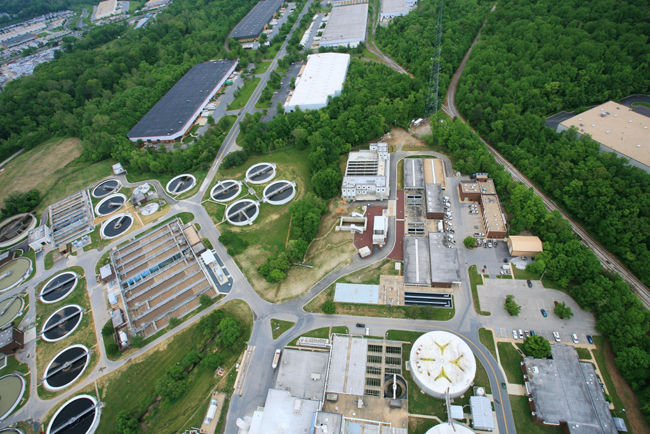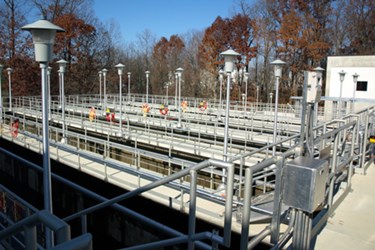Howard County, Maryland Sets The Pace In Restoring Chesapeake Bay Ecosystem
Source: Leopold -- A Xylem BrandHoward County, Maryland, Bureau of Utilities recently completed the $92-million Addition No. 7 project at the Little Patuxent Water Reclamation Plant (LPWRP) to improve the quality of the plant’s effluent discharge and to reduce harmful nutrients reaching Chesapeake Bay. The project’s various increments took over five years to complete and incorporated innovative design solutions and state-of-the-art technologies for denitrification, aeration and disinfection. The project presents a model for Maryland’s 66 largest wastewater treatment plants and possibly procurement of municipal facilities elsewhere facing increasingly stringent regulatory changes.
LPWRP serves the heart of Howard County where 56 percent of the population resides. The sewage collection system consists of 820 miles of gravity lines and force mains that connect Columbia, Savage, and North Laurel to the plant. Located in the community of Savage, LPWRP has been a recipient of repeated nutrient control measures as goals were set by the three Chesapeake Bay Agreements signed in 1983, 1987 and 2000. The agreements between the Environmental Protection Agency (EPA), Maryland, Pennsylvania, Virginia and the District of Columbia established higher effluent quality standards with the long-term goal to restore the health of Chesapeake Bay. The Second Chesapeake Bay Initiative was significant mostly because it called for a 40% reduction in nutrients reaching the Bay by 2000. This led to major investments in Biological Nutrient Removal (BNR) infrastructure in plants. BNR methods were to reduce effluent nitrogen concentrations to less than 8 mg/L and phosphorus concentrations to less than 2 mg/L in effluent releases by adding systems conducive to the growth of specific groups of beneficial micro-organisms that began the removal of nutrients from wastewater.
The third Chesapeake Bay Agreement in 2000 called for even more aggressive measures over the next decade. A new federal strategy implemented under an Executive Order by President Barack Obama in May 2009 calls for protecting and restoring the community environments throughout the 64,000-square-mile watershed and thousands of streams, creeks and rivers. The strategy includes stringent regulations to restore clean water, new conservation practices addressing four million acres of farms, preserving two million acres of undeveloped watershed and reestablishing sustainable oyster populations in 20 tributaries of the Bay. Federal agencies are to establish milestones every two years for actions to progress toward measurable environmental improvements agreed upon by the Bay States.
Maryland has committed to the installation of Enhanced Nutrient Removal (ENR) technologies that include denitrification filters and membrane reactors at the state’s largest wastewater treatment plants. New ENR facilities will treat wastewater to a maximum monthly nitrogen concentration of 3.0 mg/L nitrogen and 0.3 mg/L phosphorus. A Bay Restoration Fund established in 2004 provides state grants to help local jurisdictions fund the new ENR measures.
With a geographic footprint of 64,229 square miles, Chesapeake Bay ranks as the nation’s largest estuary and receives flows from 150 rivers and streams. Unfortunately, the multi-state region’s growth over the past 50 years brought an inevitable surge in byproduct nutrients from wastewater treatment plants that steadily eroded the vitality of the Bay’s water environment. The chronic erosion of the Bay’s water quality has had negative impacts on plant and animal life—particularly the fishery and oyster industries--in the estuary and along its tributaries. Nitrogen and phosphorus are the major problems and attributed to several sources but in large part to wastewater treatment plant discharges reaching the Bay.
Leading Systems And Equipment Earn Specification
Howard County Bureau of Utilities needed to expedite the procurement and construction for the ENR addition in order to meet the compliance date in July (2012). The utility agency adopted a progressive approach to compress the challenging schedule and lengthy process of traditional design-bid-build procurement. Instead, the utility contracted with the Calverton, MD office of Atkins Global to serve as the owner’s consultant to lead the overall project that was designated Addition No.7.
Atkins performed extensive design and engineering responsibilities. The role included recommendations on alternative design, best value based contractor selection and technology procurement. To expedite the construction and reduce overall risk, Atkins recommended awarding the main ENR and expansion improvements contract as a Construction Manager At Risk (CMAR) agreement for project delivery. The consultant worked with the County to develop the Request for Qualifications and Request for Proposals that led to selecting Clark/US, a CMAR joint venture between Clark Construction Group of Bethesda and Ulliman Schutte Construction office in Rockville, MD.
CMAR directly complemented the project delivery approach that allowed earlier stages of work to commence while later activities were not fully formalized. The approach proved effective in compressing the schedule from the project’s start in early 2009 to when the ENR addition became operational by February, 2012. This provided several months to operate the added ENR process before the state review the following July to assess compliance with the more stringent effluent regulations.

ENR System Came With Performance Warranty
Atkins evaluated both post-anoxic zones and denitrification filters as the backbone of the ENR segment of upgrades. The County’s alternative project delivery program instilled the latitude to specify pre-selected equipment based on factors such as performance, warranties, guaranteed delivery dates, etc. Following exhaustive evaluations, Atkins recommended an ENR upgrade comprised of seven, deep-bed mono-media Leopold elimi-NITE® 2.0 denitrification system from Xylem, Inc., along with control panels and related ancillary equipment.
The Leopold system is by far the most significant feature of Addition No. 7, including the impact on other municipal denitrification projects. By using an RFP based on performance and manufacturer-based warranty, Howard County was able to save two million dollars. Other municipalities stand to gain from more competitively priced procurement for their projects, as well.
The Leopold filtration system advances the LPWRP nutrient removal to the limits of proven performance. The elimi-NITE 2.0 ENR filter consists of a gravity downflow packed-bed sand filter media using methanol as an upstream biodegradable carbon source. The siliceous media in the packed-bed sand filter eliminates the need for downstream filtration or clarification units required by less efficient denitrification systems.
The filter media presents an ideal organic substrate for denitrifying microorganisms to cling while maintaining adequate hydraulic detention time for the biological reaction necessary to remove oxygen from the nitrate molecules in the process stream. When bacteria break apart the nitrate (NO3) to gain oxygen (O2), the nitrate is reduced to nitrous oxide (N2O), and, then to nitrogen gas (N2). Since nitrogen gas has low water solubility, it is released into the atmosphere as gas bubbles. The microbiological process achieves denitrification at the desired levels below 1 mg/l. At the same time, the filter material also extracts solids that include precipitated phosphorous.
Most importantly, the ENR system now in operation at LPWRP can scrub the effluent down to 3 or 4 mg/L of Total Nitrogen compared to 8 mg/L achieved by the earlier Biological Nutrient Removal (BNR) method. In tandem with the phosphorous removed upstream in the process reactors, total phosphorous can be reduced to 0.3 mg/L or less.
Pre-selection also applied to other equipment supplied by Xylem, Inc., (then known as ITT Water & Wastewater). Included were a 400-lamp WEDECO TAK 55 UV disinfection system; Flygt brand propeller mixers, along with related headworks screening, dewatering, and clarification equipment. An additional 7,000 Sanitaire ceramic diffusers were added to the process reactor aeration grids, as well as the replacement of the existing centrifugal blowers with a new turbo-type unit that significantly boost aeration while saving electricity. Moreover, the capacity of the existing BNR process was expanded with a new process reactor, secondary clarifier, launder covers on the secondary clarifiers, and a new solids processing centrifuge.
LPWRP’s daily reductions equate to an impressive 37,000 pounds of suspended solids, 4730 pounds of nitrogen, and 965 pounds of phosphorous. The individual plant will increase by more than 16 million pounds the statewide nitrogen reductions achieved by earlier upgrades across the state’s wastewater treatment infrastructure. Adding ENR to the state’s 66 largest plants should potentially reduce nutrient loading by another 7.5 million pounds of nitrogen and 260 thousand pounds of phosphorus.
The effort to restore vitality to the Bay has come a long way from the earliest baby steps that simply defined goals to the giant strides achieved at LPWRP.
Copyright © 1996 - 2014, VertMarkets, Inc. All rights reserved. To subscribe or visit go to: http://www.wateronline.com
